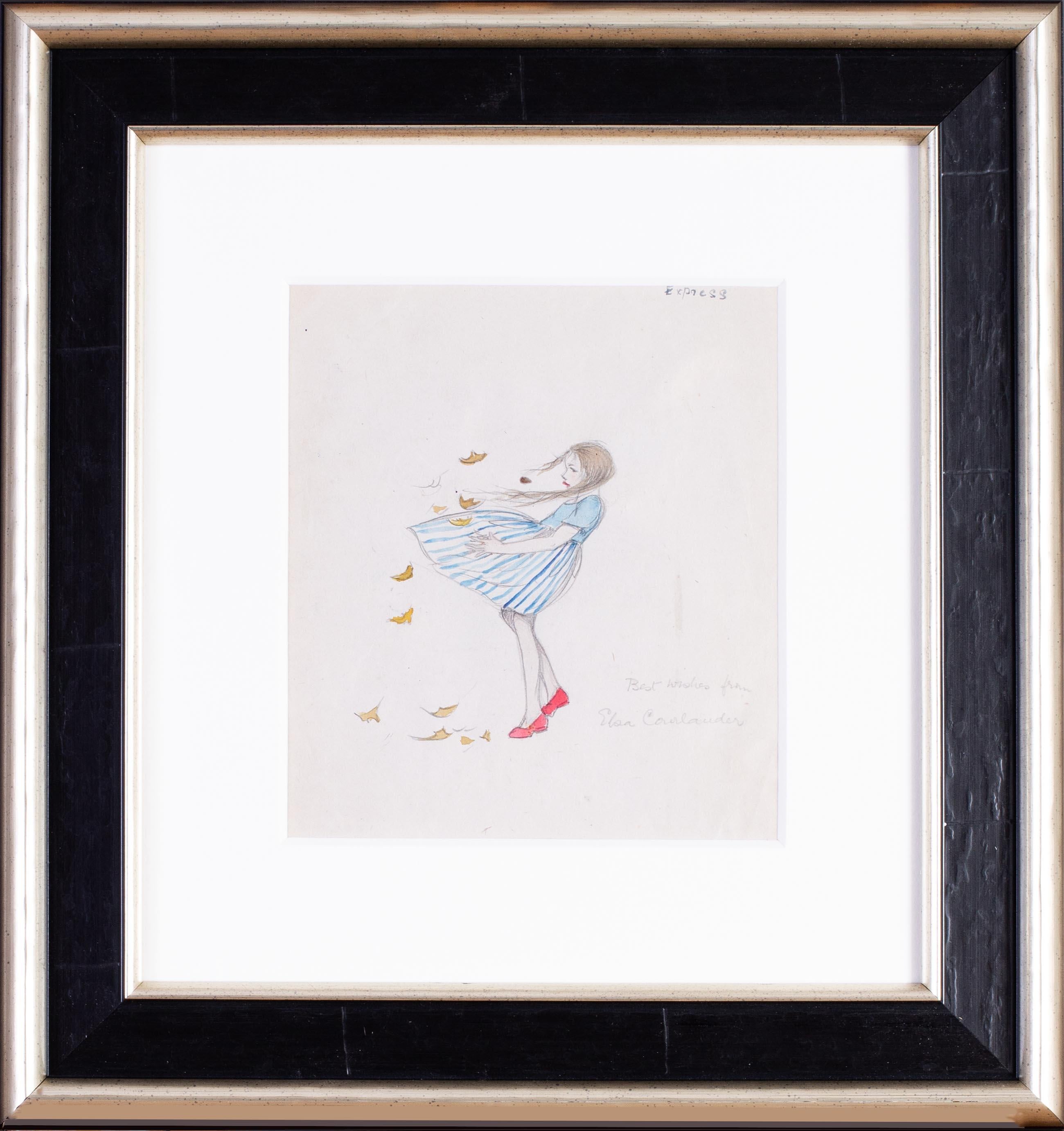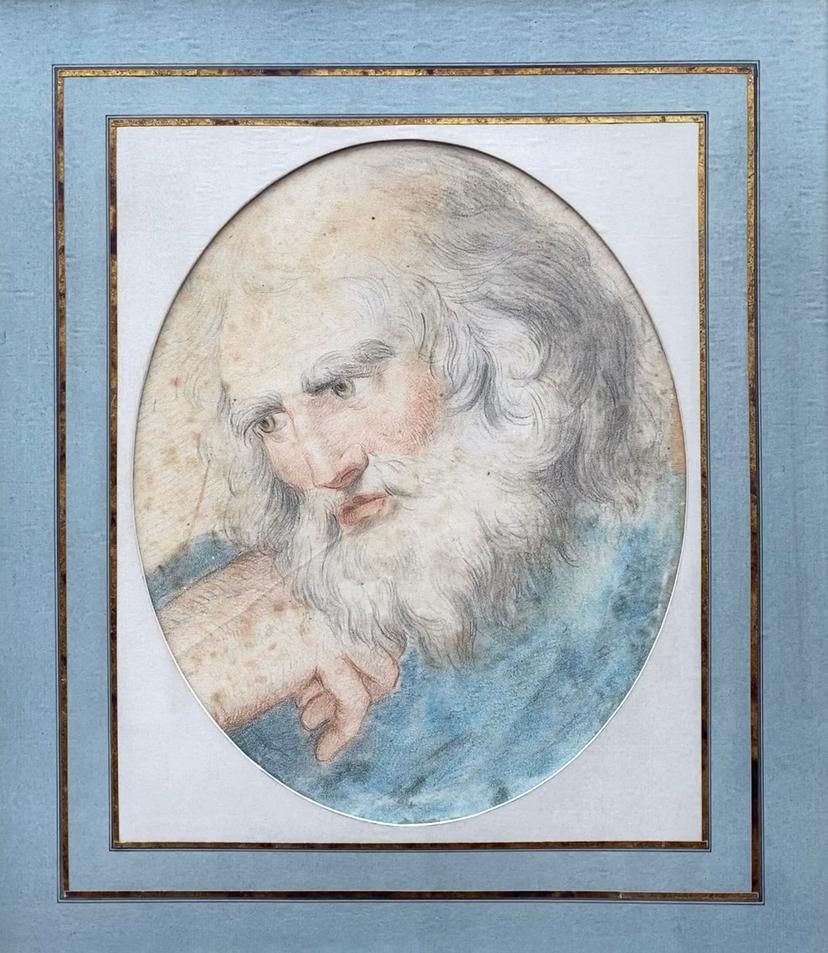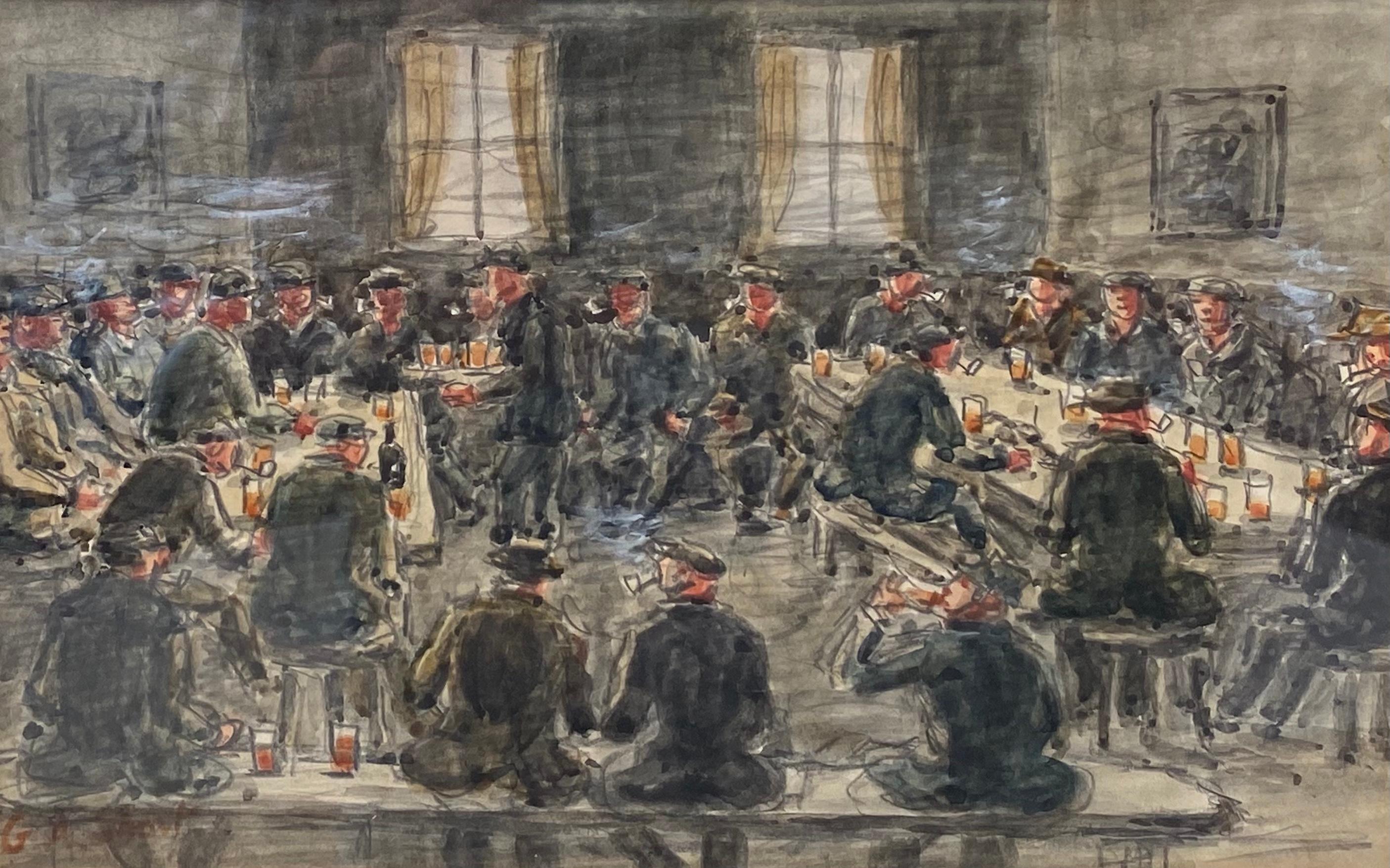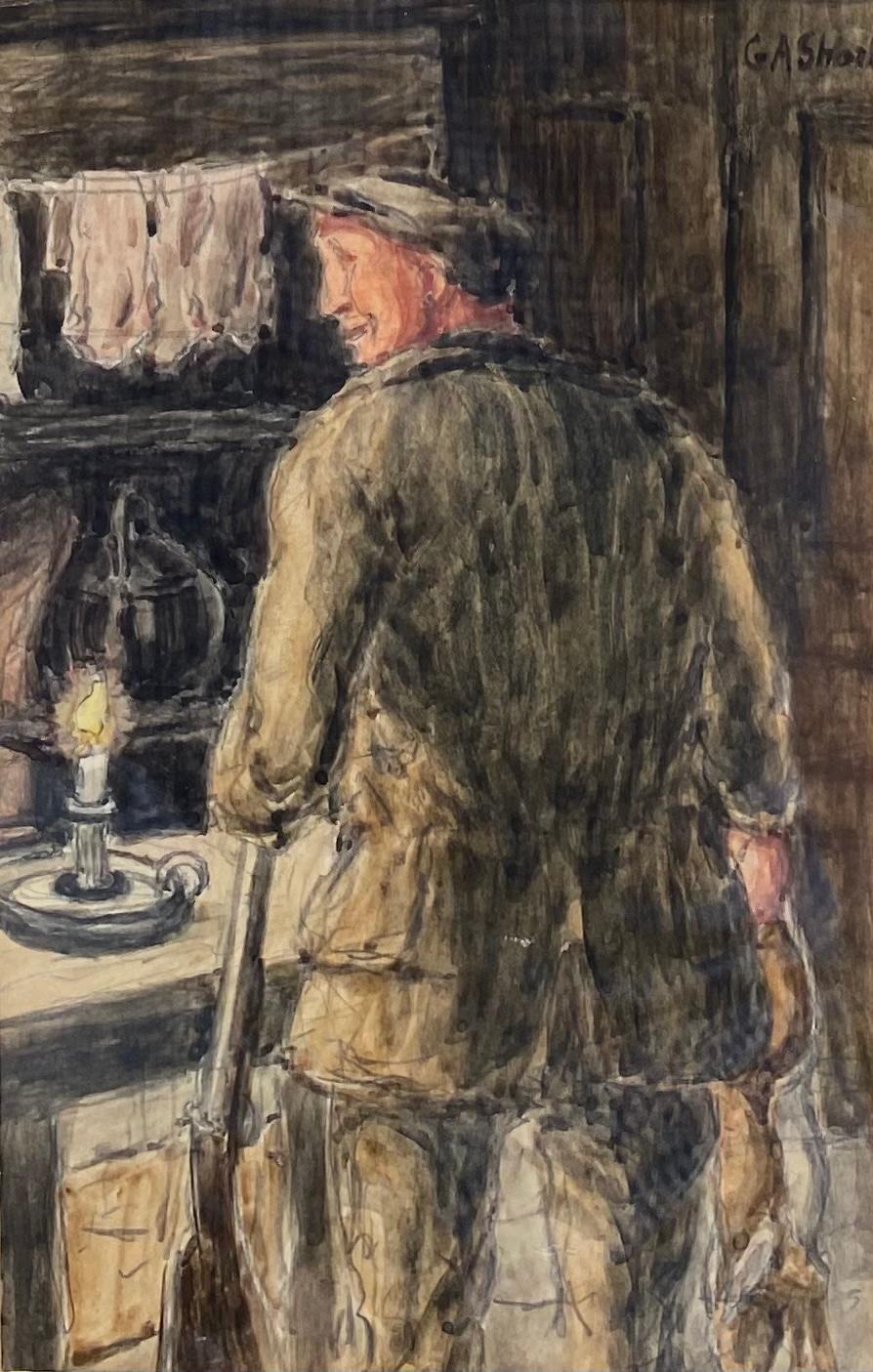Items Similar to The Buttonhole By Charles Spencelayh
Want more images or videos?
Request additional images or videos from the seller
Charles SpencelayhThe Buttonhole By Charles SpencelayhCirca 1940
Circa 1940
About the Item
Charles Spencelayh
1865-1958 British
The Buttonhole
Signed “C.SPENCELAYH” (lower left) and inscribed “This Drawing was accepted into the Royal Academy but crowded out for want of space” (en verso)
Watercolor and pencil with gum arabic on paper
One of the most important English genre painters in the Academic style, Charles Spencelayh's anecdotal scenes are among the best of his age. This work, entitled The Buttonhole, captures the celebrated painter’s preferred subject – an elderly gentleman performing an ordinary task. Spencelayh’s talent for portraying the common man with an engaging sentimentality remains unsurpassed, and his everyday narratives imbue his work with an undeniable timelessness.
He trained at the National Art Training School (later renamed the Royal College of Art), where he flourished in his figural drawings. Spencelayh continued his education in Paris, where he exhibited at the Salon with much success. His primary exhibition venue throughout his career was the Royal Academy, where he showcased 30 paintings from 1912 to 1958. His incredible canvases were hung in the leading art venues of the day and gained him membership into the most prestigious art societies.
During his lifetime, Spencelayh was greatly admired by many influential collectors, including Queen Mary, who provided the artist and his family a residence in Manchester. Spencelayh painted a postage-size portrait of King George V for the Queen’s dollhouse that currently resides in Windsor Castle. Today, his work is highly sought after, though examples rarely become available on the market.
Circa 1940
Paper: 15 1/2" high x 11 3/4"
Frame: 26 1/2" high x 22 5/8" wide
Provenance:
Charles Nicholls & Son, Manchester
Sotheby’s, Chester, 27th April 1989
Private collection, United Kingdom
M.S. Rau, New Orleans
- Creator:Charles Spencelayh (1865-1958, British)
- Creation Year:Circa 1940
- Dimensions:Height: 26.5 in (67.31 cm)Width: 22.63 in (57.49 cm)Depth: 1.38 in (3.51 cm)
- Medium:
- Movement & Style:
- Period:
- Condition:
- Gallery Location:New Orleans, LA
- Reference Number:
About the Seller
5.0
Vetted Seller
These experienced sellers undergo a comprehensive evaluation by our team of in-house experts.
Established in 1912
1stDibs seller since 2013
15 sales on 1stDibs
Typical response time: 6 hours
- ShippingRetrieving quote...Ships From: New Orleans, LA
- Return PolicyThis item cannot be returned.
More From This SellerView All
- La femme préhistorique (Prehistoric Woman)By James Jacques Joseph TissotLocated in New Orleans, LAJames Tissot was among the most successful and critically acclaimed artists of the Victorian era. Although the artist is celebrated for his elegant scenes of fashionable life in Paris and London, this work is a fascinating rarity within his oeuvre. In this monumental pastel, Tissot depicts a prehistoric woman draped in a tiger skin, presented with a striking pose and heroic air. His delicate portraiture, combined with his fascination with conveying texture, demonstrates why he was one of the most revered artists of his generation, and La femme préhistorique illustrates the remarkable technique for which he was renowned. This work was completed in preparation for a series of works exploring the Old Testament undertaken by Tissot from 1899-1902 that remained unfinished at the time of his death. A portion of this series focused on illustrations of Adam and Eve, and among these sketches were images of a nude Eve partially draped in animal furs. Towards the end of his life, following his conversion to Catholicism, biblical subjects became important to the artist. A few years before this work was completed, Tissot embarked upon a highly ambitious group of nearly 300 watercolors illustrating the New Testament, presenting the illustrated epic in its entirety at the Paris Salon of 1894. Both of these series were a critical artistic departure for the artist, stemming from a desire to create works separated from his typical images of modern society. This pastel imagines Eve as the prototype of womanhood in the guise of a prehistoric woman. Tissot rarely painted the nude, and his skill as a draftsman highlights the figure's natural beauty, contrasting it with the stark landscape surrounding her. Although a study, this monumental work is incredibly well-finished and highly engaging, with the statuesque model commanding the majority of the canvas. Her pose is strong and theatrical, and she addresses the viewer with a direct, confident gaze. The imagined historical subject of this drawing is grounded by Tissot’s exceptional attention to detail. A master of conjuring an array of textures, Tissot showcased this ability in this work by juxtaposing many types of fabrics and natural elements within one composition. The tiger skin with which the woman partially covers herself was a favorite studio prop of Tissot’s, appearing in many of his most influential works from the period, including several paintings of his partner and favorite model Kathleen Newton. It, in particular, showcases the artist’s understanding of texture, yet it also serves as an exotic element that elevates the sensuality of the scene when placed against the woman’s bare skin. Born in 1836 in the port town of Nantes, Tissot traveled to Paris at the age of 20 in order to join the studios of Hippolyte Flandrin and Louis Lamothe. During this period, he became close with James Abbott McNeill Whistler, Edgar Degas and Edouard Manet, and the impact of these friendships is reflected in his portraits of modern life. Having enjoyed considerable success in Paris during the 1860s, Tissot fought in the Siege of Paris, and after the fall of the Commune in 1871, he went to London, where he stayed for the next ten years. He was met with incredible success there, and he also met the love of his life, Kathleen Newton, a divorcée, with whom he lived from about 1876 until her death in 1882. Today he is regarded among the great masters of Belle Époque painting, and his works can be found in important collections worldwide, including the Metropolitan Museum of Art, the Brooklyn Museum, the National Gallery of Art, the Musée d’Orsay, the Tate Gallery and many others. This pastel remained in Tissot's private collection until his death in 1902 and is referenced in the posthumous 1902-3 valuation of Tissot's home at 64 avenue du Bois...Category
Early 20th Century Academic Nude Drawings and Watercolors
MaterialsLaid Paper, Canvas, Oil Pastel, Pastel
- Musiciens Sur Fond Multicolore By Marc ChagallBy Marc ChagallLocated in New Orleans, LAMarc Chagall 1887-1985 Russian Musiciens sur fond multicolore (Musicians on a multicolored background) Signed 'Chag' (on the sleeve of the right figure); stamped with the signature 'Marc Chagall' (lower right) Tempera, gouache, colored ink and India ink and pastel on paper “The fact that I made use of cows, milkmaids, roosters and provincial Russian architecture as my source forms is because they are part of the environment from which I spring and which undoubtedly left the deepest impression on my visual memory of the experiences I have." - Marc Chagall Marc Chagall’s 1981...Category
20th Century Post-Impressionist Figurative Drawings and Watercolors
MaterialsPaper, Pastel, Ink, India Ink, Tempera, Gouache
- La Dionée Dite Gobe-Mouches By ErtéBy Erte - Romain de TirtoffLocated in New Orleans, LAErté (Romain de Tirtoff) 1892-1990 Russian-French La dionée dite Gobe-mouches(Venus Flytrap) Signed "Erté" (lower right) Inscribed ---- (en verso) Gouache on paper Daring and mysterious, this original gouache from the creative mind of Erté features the sinuous figure of a woman wearing a unique ebony and sanguine body suit with a dramatic wing-like cape. Entitled La dionée dite Gobe-mouches or Venus Flytrap, this work embodies the Art Deco glamour and tongue-in-cheek artistry for which the artist's designs are so beloved. Inspired by the famed volume of poems from iconic French writer Charles Baudelaire, this ensemble showcases Erté's sartorial interpretation of La Vampire from Baudelaire's Les Fleurs du mal. This elegant composition exudes the quintessential opulence and drama that only Erté, the oft-called "Father of Art Deco," could achieve. La dionée dite Gobe-mouches showcases the breadth of Erté's creativity and his design expertise. First published in 1857, Baudelaire's Les Fleurs du mal was controversial for its suggestive content and themes of decadence and eroticism. The volume provided a wealth of inspiration for Erté and he drew from several specific poems to create original fashion sketches...Category
20th Century Art Deco Figurative Drawings and Watercolors
MaterialsPaper, Gouache
- L'Aurore boréale by ErtéBy Erte - Romain de TirtoffLocated in New Orleans, LAErté (Romain de Tirtoff) 1892-1990 Russian-French L'Aurore boréale(The Aurora Borealis) Signed "Erté" (lower right) Inscribed ---- (en verso) Gouache on paper In this colorful gouache, Erté draws an enticing and unique fashion design on his model's elegantly elongated figure. Crowned by an elaborate headdress, the woman wears a daring gauzy caftan that drapes dangerously low, celebrating her nude form. EntitledL'Aurore Boréale" or The Aurora Borealis, this work embodies the Art Deco glamour for which the artist's designs are so beloved. This ensemble was inspired by Les Fleurs du mal, the famed volume of poems from iconic French writer Charles Baudelaire. As the name suggests, this creative design links the celebrated "fleur" orchids with one of nature's other great marvels, the Aurora Borealis. This refined piece of art radiates the essential luxury and theatricality that could only be accomplished by Erté, oft referred to as the "Father of Art Deco." First published in 1857, Baudelaire's Les Fleurs du mal was controversial for its suggestive content and themes of decadence and eroticism. The volume provided a wealth of inspiration for Erté and he drew from several themes to create original fashion sketches...Category
20th Century Art Deco Figurative Drawings and Watercolors
MaterialsPaper, Gouache
- Costume tailleur by ErtéBy Erte - Romain de TirtoffLocated in New Orleans, LAErté (Romain de Tirtoff) 1892-1990 Russian-French Costume tailleur(Tailored suit) Signed "Erté"(lower right) Inscribed "No. 55"(en verso) Gouache on paper This striking gouache on...Category
20th Century Art Deco Figurative Drawings and Watercolors
MaterialsPaper, Gouache
- Les Bambous by ErtéBy Erte - Romain de TirtoffLocated in New Orleans, LAErté (Romain de Tirtoff) 1892-1990 Russian-French Les Bambous Signed "Erté" (lower right) Inscribed "No. 361" (en verso) Gouache and gold on paper Erté renders a stylish gold an...Category
20th Century Art Deco Figurative Drawings and Watercolors
MaterialsGold
You May Also Like
- A 1930s drawing of a young girl in a blustery windy day with autumn leavesLocated in Petworth, West SussexElsa Carlander (British, circa 1930) An autumn gust Watercolour and pencil on paper Signed and inscribed ‘Best wishes from Elsa Carlander’ (lower right) 6.5/8 x 5.7/8 in. (16.8 x 15 ...Category
1930s Academic Figurative Drawings and Watercolors
MaterialsWatercolor, Pencil, Paper
- Set of six 19th Century studies or Turkish characters by Maltese artist PreziosiLocated in Petworth, West SussexCount Amadeo Preziosi (Maltese, 1816 – 1882) A set of six pencil and watercolour studies or Turkish characters including street vendors, a Turkish sold...Category
19th Century Academic Figurative Drawings and Watercolors
MaterialsWatercolor, Pencil, Paper
- “Portrait of a Head”Located in Southampton, NYLate 18th century mixed media portrait of the head of an old man, perhaps the biblical figure Moses. Italian school . Composed of graphite, colored chalk, watercolor and gouache on ...Category
1780s Academic Figurative Drawings and Watercolors
MaterialsGouache, Paper, Chalk, Graphite, Watercolor
- “The Hunter”Located in Southampton, NYOriginal watercolor with graphite tracings of a solitary hunter in the field by the British artist, George Anderson Short. Signed bottom right. ...Category
1940s Academic Figurative Drawings and Watercolors
MaterialsWatercolor, Archival Paper, Graphite
- “Tavern Meeting”Located in Southampton, NYOriginal watercolor with graphite tracings of interior crowded pub scene by the British artist, George Anderson Short. Signed bottom left. Circa...Category
1940s Academic Figurative Drawings and Watercolors
MaterialsWatercolor, Archival Paper, Graphite
- “Bringing Home the Game”Located in Southampton, NYOriginal watercolor with graphite tracings of a hunter bring home the fresh game by the British artist, George Anderson Short. Signed top right. ...Category
1940s Academic Figurative Drawings and Watercolors
MaterialsWatercolor, Archival Paper, Graphite
Recently Viewed
View AllMore Ways To Browse
Vintage Dollhouse
Sada Yacco
Sam Savitt
Jean Duplessis Bertaux On Sale
Johannes Volckamer
Amanda Watt On Sale
Everett Shinn On Sale
Felix Russman
Frank Dobson On Sale
George Demont Otis On Sale
Helen Sewell Rennie On Sale
Hendrick V. Tavernier On Sale
Henry Reuterdahl
J Boucher Watercolor
Jean Corniche
Jean Pons On Sale
Julius Frick
Kirk Mangus On Sale





